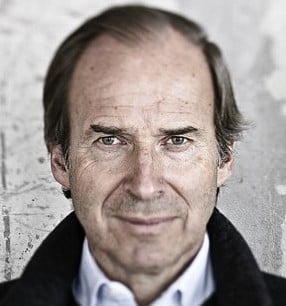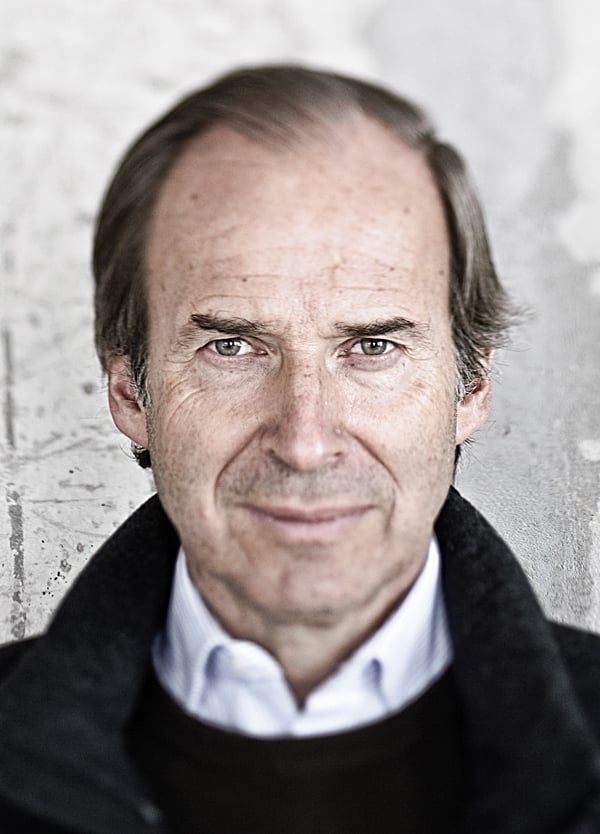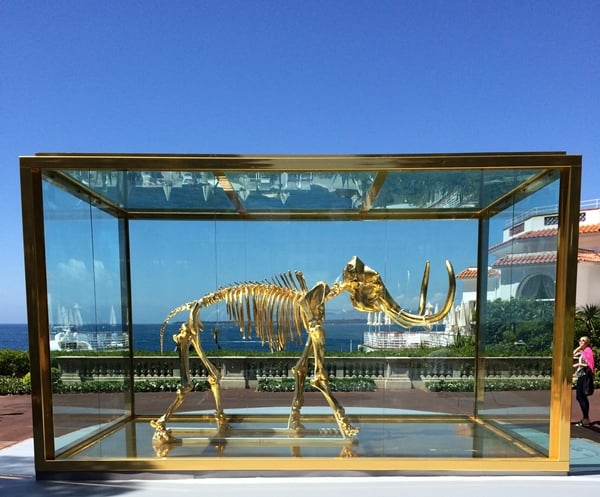


CANNES, France. — Am writing these lines as Damien Hirst‘s spectacular new piece Gone but not Forgotten is being dismantled by an army of art handlers.
Am at the Hôtel du Cap in Cap d’Antibes, France, where amfAR, the Foundation for AIDS Research, has been staging for 20 years Cinema Against AIDS, the annual fundraising gala held to coincide with the Cannes film festival. The event has over the years, thanks to the tireless efforts of Dame Elizabeth Taylor, founder of amfAR, Sharon Stone, and Harvey Weinstein, raised umpteen millions in an effort to “make AIDS history” by 2020. It is a high-octane event that brings together a unique concentration of glamour, beauty, generosity, wealth and sex appeal. The presence of innumerable stars seems to act as an extra enticement for oligarchs and billionaires to bid on what are usually “money can’t buy” experiences such as walking the red carpet during the Oscars with Leonardo DiCaprio, playing a game of tennis with Prince Albert of Monaco, or taking a swimming lesson with his wife Princess Charlene, a former Olympic swimmer.
As someone obsessed with music, I feel in heaven as one top musical act chases the other between the various lots being sold. This year alone there were Lana del Rey, Aloe Blacc, Andrea Bocelli, and Robin Thicke. The brilliant producer of the whole thing is Andrew Boose, who behind the scenes makes sure that the guests are having a fabulous time. There is not one dead moment and the rhythm of the evening is masterfully orchestrated by him. All this happens under the watchful eye of Harvey Weinstein who keeps it well focused on the main objective which is to raise as much money as possible.
For the past four editions, I have had the privilege to serve as official auctioneer. The other years I was given at the time of my arrival at the Hôtel du Cap the list of items I was expected to sell at auction during the evening. This time I received an email from Andy Boose four days ahead with the image of a stunning work that Damien Hirst was donating for the 21st annual amfAR gala. It showed in profile the skeleton of a mammoth covered in gold standing in a gilded steel vitrine. I was in awe for a number of reasons.
First of all it confirmed that Damien Hirst is unquestionably the world’s most generous artist. As an active auctioneer on the charity auction circuit around the world, I have sold more works by him than by any other artist. It is of course the same artists that are endlessly solicited by innumerable charities and institutions. The small image I saw on my iPhone looked as if it potentially could be one of the best works Damien had ever done. I asked Andy what was the estimate. There wasn’t any but it was hoped I could get €4 to €5 million ($5.4 to $7.8 million) for it.

Damien Hirst, Gone but not Forgotten (2014)
Photo: Courtesy Simon de Pury.
On one hand, I felt that this was a conservative expectation for what looked potentially like such a major work and at the same time it made me nervous since €1 to €2 million ($1.4 to $2.7 million) is normally the most that you could hope for an unprepared guest to spontaneously spend at a benefit gala dinner. The quality of this work would have made it ideally placed in the context of the record contemporary art auctions that I had attended at Christie’s, Sotheby’s, and Phillips a week earlier in New York. These auctions benefited from weeks of a marketing buildup leading to the auctions, where captive audiences gathered specifically for them.
I set out to find out more information on this work. In a paleontology sale that was held at Christie’s in April 2007, the youngest son of the legendary collector of French 18th-century furniture Djahanguir Riahi bought for a record price “the president,” the skeleton of a 10,000 year old Siberian mammoth from the Pleistocene era. It is he who envisioned that this could potentially form raw material for a great work by Damien Hirst. He contacted an art dealer close to the artist who did not seem particularly impressed by the idea. He then approached Milutin Gatsby, who is a good friend of Damien and has been a tireless supporter of amfAR over the years. Milutin instantly saw a great opportunity for amfAR and planted the idea with Damien. The fact that Damien’s friend, model and actress Katie Keight, is being predicted to stardom by Harvey Weinstein surely can’t have hurt either.
After weeks of painstaking work taking place under the artists supervision, all parts of the skeleton got covered in gold leaf and it was placed into a spectacular glass and powder-coated stainless steel vitrine. The work was ready at the very last minute to be shipped to Cap d’Antibes.
Gone but not Forgotten arrived on the morning of the event and had to be built up under pouring rain at the bottom of the wide alley leading up from the sea to the hotel. The minute it was erected, the rain stopped, and one by one the people who were staying in the hotel began coming out to stand in front of it in admiration. There was no question any longer for me that this was not just one of Damien’s strongest works, but possibly his very best ever. Its scale is majestic. Even though I had read that its measurements were 164,6 × 282,1 × 179,8 inches, it is only standing next to it that you could fully realize its impact. The moment Andy Boose had sent me the image, my wife Michaela and I forwarded it to a number of potential contenders around the world. The amfAR office, Damien Hirst’s studio, and Milutin Gatsby did the same. The night before the event, dinners were taking place on several yachts as usually happens during the festival. Rapidly Damien’s mammoth became the main subject of conversation.
Since the historic single artist auction “Beautiful Inside My Head Forever” that took place at Sotheby’s in London in October 2008 on the same day that Lehman Brothers went belly up, there had not been any work by Hirst of similar quality or importance available on the open market. This work is the most significant addition to Hirst’s “Natural History” series, which began in the early 1990s with works that include the 13-foot tiger shark in formaldehyde The Physical Impossibility of Death in the Mind of Someone Living. What had happened in the meantime was the Hirst retrospective at Tate Modern in 2012 that attracted a record number of visitors and the even more impressive show that took place in 2013 in Doha at Al Riwaq under the auspices of the Qatar Museums Authority. The same year Sheikha Al Mayassa (who ranks among history’s greatest art patrons along with the Medicis, King François I, and Catherine the Great) inaugurated a series of 14 large bronze sculptures, “The Miraculous Journey,” that she had commissioned from Hirst to be situated outside the first women’s hospital in the Middle East in Sidra, Qatar.
Despite the fact that I have been conducting auctions for a little while by now, I always feel incredibly tense in the hours leading up to it, regardless whether it is a commercial or a benefit auction. I get so nervous in fact that it is each time as if I were conducting my first auction ever. Here there was no safety net that an auctioneer has when a third party has in advance given a guarantee in form of an irrevocable bid. There was no reserve price; I therefore decided to start low. I was impressed by Damien’s generosity but also by his razor-blade decision to have it sold with nearly no pre-auction marketing. This demonstrated a boldness that is in sharp contrast with most of his artist colleagues. They are ultra cautious and often paranoiac about possibly setting a foot wrong and hurting their standing in the market. It reminded me a bit of Beyoncé, who, to everyone’s total surprise and without any previous marketing buildup whatsoever, launched her self-titled last album in mid-December on iTunes, Spotify, and YouTube, as well as in record stores .
The evening was well under way by the time Damien’s work came up. To bullish bidding, I had sold a Serpenti necklace made by Bulgari that Carla Bruni Sarkozy was wearing with incredible grace, beauty and charm; Justin Bieber had attempted to buy it for his mother. Sharon Stone, with her usual sizzling appeal, had managed to extract €3 million ($4 million) from a Russian oligarch for a Carine Roitfeld–curated ensemble of 22 dresses made by the world’s leading fashion makers. Aloe Blacc had just sung two of his superhits. I went on the stage not knowing what to expect. I had carefully planned the introduction.

Damien Hirst, Gone but not Forgotten (2014)
Photo: Courtesy Simon de Pury.
First I waited until total silence had been restored and I could count on the full concentration of the audience. I then gave all attendees the essence and key bits of information and context about the piece, its importance and value. I explained the important position this work took in Hirst’s overall oeuvre and how lucky everybody present was that this was not being sold in an international art auction, besides which there was of course no buyers premium so that every euro could go to amfAR. I felt the tension arising, and the first bidder jumped up eager to bid, raising both hands in the air.
It was Robert Tchenguiz, a London-based businessman who shouted out his initial bid of €1 million. At the speed of light, the bidding climbed in €1 million increments and was coming from bidders all over the packed tent. At around €6 or €7 million ($8.2 or $9.5 million) I slowed down the pace and the playing field narrowed to two contenders who were bidding from different tables while holding each other’s gaze. After a long pause, during which the underbidder finally decided not to go on bidding, I was able to knock it down to the lucky new owner for €11 million ($15 million) to frenetic applause of the room. I got my own recompense immediately after when an overjoyed Sharon Stone fell into my arms.
Len Blavatnik, the London-based entrepreneur and philanthropist, emerged as winner of the bidding contest. (I am not divulging any secrets by revealing his identity, as the press instantly reported it.) He told me he was planning to install it in a real estate project he is building in Miami. The mammoth no doubt will become a landmark attraction and a symbol for his new site. The $15 million it represents is the fourth highest price ever obtained at public auction for a work by Damien Hirst and by far the highest since 2008. In purely financial terms, the new owner, besides being responsible together with Damien for the highest single donation ever made by an artist to a charity auction and having made one of the greatest single donations in the fight against AIDS, is getting an excellent deal. My bet shared by the few art market insiders who were here is that he rapidly will be able not only to recoup what he paid for it but could sell it for a handsome profit.
A close friend of the underbidder told me that he had been prepared to bid far more, but that phone calls to his contacts at two of the main auction houses had advised him not to bid beyond €6 million. They as anyone else who was not in Cannes of course had the serious disadvantage of not having physically seen the piece in the bones in situ. The French saying “Les absents ont toujours tort” (“Those who are absent are always wrong”) was never more true. The day after the gala, the sun was shining, the sky was radiant blue, and the work was visible in all its glory. All day long, hotel guests and tourists were flocking around it. It became the ultimate prop for myriad Instagram selfies. This is only a mild prefiguration of what will happen when it will be reinstalled in Miami. Twenty-four hours later the mammoth piece was dismantled and moved. Something is clearly missing now in front of the Hôtel du Cap: gone but not forgotten!
Simon de Pury tweets and Instagrams from @simondepury.





